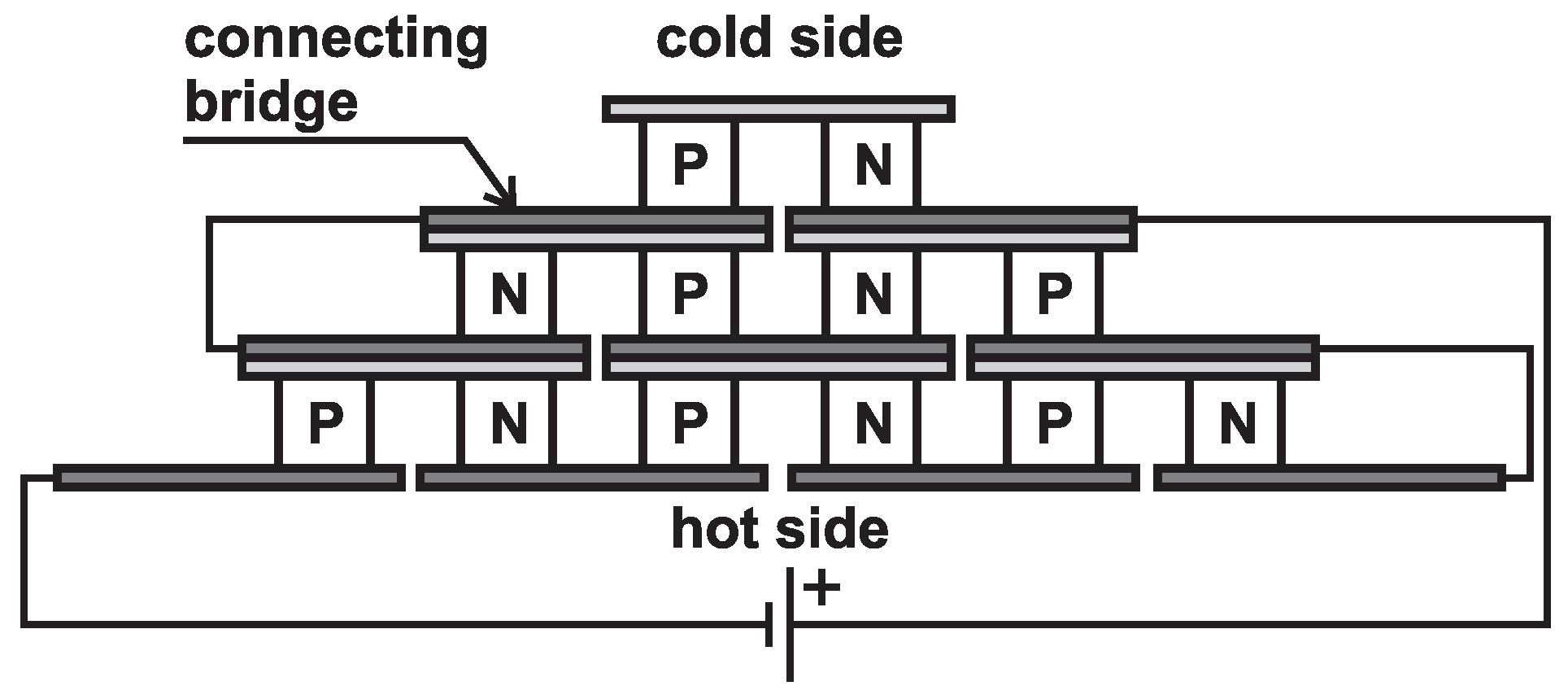Analysis of the Appropriateness of the Use of Peltier Cells as Energy Sources
Abstract
:1. Introduction
1.1. Cells for Cooling
1.2. Cells for Generation of Electric Energy
2. Problem Description
3. Ideological Conceptual Design
4. Experimental Verification of Efficiency of Peltier Cells
4.1. The First Experiment
4.2. The Second Experiment
4.3. The Third Experiment
4.4. The Fourth Experiment
5. Simulation of Real Operation at the Mining Dump
6. Summary of the Experiments
7. Conclusions
Acknowledgments
Author Contributions
Conflicts of Interest
Abbreviations
| CH | Methane |
| CO | Carbon monoxide |
| CPU | Central processing unit |
| DC | Direct current |
| DS18B20 | 1-Wire digital thermometer |
| Pt100 | Platinum resistance thermometer |
| TEC1 | Thermoelectric cooler—type MCTE1-12715L-S |
| TEC2 | Thermoelectric cooler—type TEC-12710 |
| TEG | Thermoelectric power generator—unknown type |
References
- Seebeck, T.J. Ueber die magnetische Polarisation der Metalle und Erze durch Temperatur-Differenz. Ann. Phys. 1826, 82, 133–160. [Google Scholar] [CrossRef]
- Min, G.; Rowe, D.M. Experimental Evaluation of Prototype Thermoelectric Domestic-Refrigerators. Appl. Energy 2006, 83, 133–152. [Google Scholar] [CrossRef]
- LaGrandeur, J.; Crane, D.; Hung, S.; Mazar, B.; Eder, A. Automotive Waste Heat Conversion to Electric Power using Skutterudite, TAGS, PbTe and BiTe. In Proceedings of the 25th International Conference on Thermoelectrics (ICT’06), Vienna, Austria, 6–10 August 2006; pp. 343–348. [CrossRef]
- Hajovsky, R.; Vojcinak, P.; Pies, M.; Koziorek, J. Thermal Response Test (TRT)—System for Measurement of Thermal Response of Rock Massif. In Proceedings of the 12th IFAC Conference on Programmable Devices and Embedded Systems, Velke Karlovice, Czech Republic, 25–27 September 2013; pp. 126–131. [CrossRef]
- Goldsmid, H.J. Thermoelectric Refrigeration; Plenum Press: New York, NY, USA, 1964. [Google Scholar]
- Goldsmid, H.J. Electronic Refrigeration; Pion: London, UK, 1986. [Google Scholar]
- Goldsmid, H.J. Conversion Efficiency and Figure-of-Merit. In Handbook of Thermoelectrics; Rowe, D.M., Ed.; CRC Press: New York, NY, USA, 2007; pp. 19–40. [Google Scholar]
- Riffat, S.B.; Ma, X. Thermoelectrics: A Review of Present and Potential Applications. Appl. Thermal Eng. 2003, 23, 913–935. [Google Scholar] [CrossRef]
- Pies, M.; Hajovsky, R.; Ozana, S. Autonomous Monitoring System for Measurement of Parameters of Heat Collection Technology at Thermal Active Mining Dumps. Elektron. Elektrotech. 2013, 19, 62–65. [Google Scholar] [CrossRef]
- Hajovsky, R.; Pies, M.; Ozana, S.; Hajovsky, J. Heat energy collection from thermally active mining dump Hedvika. In Proceedings of the IEEE International Conference on Automation Science and Engineering, Taipei, Taiwan, 18–22 August 2014; pp. 44–49. [CrossRef]
- Bilek, O.; Krejcar, O. Possibility of using embedded sensors of smart devices for augmented reality application. In Proceedings of the 10th International Conference on Future Information Technology, Hanoi, Vietnam, 18–20 May 2015; pp. 79–84. [CrossRef]
- Prauzek, M.; Musilek, P.; Watts, A.G.; Michalikova, M. Powering environmental monitoring systems in arctic regions: A simulation study. Elektron. Elektrotech. 2014, 20, 34–37. [Google Scholar] [CrossRef]
- Vanus, J.; Novak, T.; Koziorek, J.; Konecny, J.; Hrbac, R. The proposal model of energy savings of lighting systems in the smart home care. In Proceedings of the 12th IFAC Conference on Programmable Devices and Embedded Systems, Velke Karlovice, Czech Republic, 25–27 September 2013; pp. 411–415. [CrossRef]













| Cold Side Temperature | Hot Side Temperature | Temperature Difference | Voltage |
|---|---|---|---|
| 18 | 18 | 0 | 0 |
| 23 | 38 | 15 | 0.05 |
| 26 | 51 | 25 | 0.1 |
| 30 | 59 | 29 | 0.14 |
| 33 | 67 | 34 | 0.2 |
| 37 | 74 | 37 | 0.22 |
| 43 | 84 | 41 | 0.24 |
| 43 | 87 | 44 | 0.25 |
| 44 | 105 | 56 | 0.4 |
| 53 | 118 | 65 | 0.55 |
| Cold Side Temperature | Hot Side Temperature | Temperature Difference | Voltage |
|---|---|---|---|
| 13 | 13 | 0 | 0 |
| 38 | 105 | 67 | 0.7 |
| 40 | 184 | 115 | 1.55 |
| 44 | 188 | 144 | 2.2 |
| 45 | 198 | 153 | 2.53 |
| Cold Side Temperature | Hot Side Temperature | Temperature Difference | Voltage |
|---|---|---|---|
| 13 | 13 | 0 | 0 |
| 15 | 48 | 33 | 0.86 |
| 18 | 85 | 67 | 1.3 |
| 26 | 134 | 108 | 1.8 |
| 38 | 152 | 114 | 2.02 |
| 40 | 169 | 129 | 3.5 |
© 2016 by the authors; licensee MDPI, Basel, Switzerland. This article is an open access article distributed under the terms and conditions of the Creative Commons Attribution (CC-BY) license (http://creativecommons.org/licenses/by/4.0/).
Share and Cite
Hájovský, R.; Pieš, M.; Richtár, L. Analysis of the Appropriateness of the Use of Peltier Cells as Energy Sources. Sensors 2016, 16, 760. https://doi.org/10.3390/s16060760
Hájovský R, Pieš M, Richtár L. Analysis of the Appropriateness of the Use of Peltier Cells as Energy Sources. Sensors. 2016; 16(6):760. https://doi.org/10.3390/s16060760
Chicago/Turabian StyleHájovský, Radovan, Martin Pieš, and Lukáš Richtár. 2016. "Analysis of the Appropriateness of the Use of Peltier Cells as Energy Sources" Sensors 16, no. 6: 760. https://doi.org/10.3390/s16060760
APA StyleHájovský, R., Pieš, M., & Richtár, L. (2016). Analysis of the Appropriateness of the Use of Peltier Cells as Energy Sources. Sensors, 16(6), 760. https://doi.org/10.3390/s16060760






